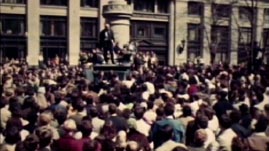Teachers' Domain - Digital Media for the Classroom and Professional Development
User: Preview

Source: Boston Public Library Archive
Citizens gather at a public rally in Boston, Massachusetts, following the assassination of civil rights leader Martin Luther King, Jr., in this archival news footage from April 1968. One speaker featured in the footage states that King had been “prepared to give his life for justice in America” in Boston and in the various cities King had visited throughout the South. Another speaker talks about America’s unwillingness—not its inability—to end racism, questions the meaning of “law and order,” and calls violence the “inevitable outcome of oppression.”
This video is primary source footage and has not been extensively edited.
In the spring of 1968, America was a deeply divided society. Despite the 1954 Brown v. Board of Education ruling that ended de jure segregation (segregation imposed by law) in schools, racial discrimination persisted. There was a growing uneasiness among urban blacks in particular, who felt they were being left behind as the rest of America was prospering. Antiwar sentiments ran high following the escalation of the Vietnam War in 1965. People watched as thousands of 18- and 19-year-olds were drafted into the military and sent to combat.
The sentiments these events inspired contrasted with the great optimism shared by many Americans at the outset of the 1960s. Pitching his “New Frontier” agenda, a package of laws and reforms that sought to eliminate injustice and inequality, President John F. Kennedy had led people to see government as having the answer to society’s biggest problems, including racial inequality and poverty. However, Kennedy’s own assassination, the failure of both laws and government to solve problems facing blacks, and the fact that King, a champion of nonviolent change, had himself died violently, led many black leaders to take a more radical approach.
Spontaneous rioting in poor black neighborhoods, most notably in Los Angeles in 1965 and Detroit in 1967, reflected a type of response that would be repeated over and over again across the country in the latter half of the decade. A report by a presidential commission studying the Detroit riots concluded that the nation was “moving toward two societies; one black, one white, separate and unequal.” King’s killing in April 1968 further widened this rift. In the immediate aftermath, more than 100 cities across the country experienced rioting. Nearly 50 people died, and property damage was in the millions.
As the news footage shows, disillusionment was shared not just among blacks, but among whites as well. Those who rallied in Boston pointed out that King’s violent death was an inevitable result of the racist society they were living in and its unwillingness to change. According to one of the protesters seen in the footage, the very meaning of law and order in America had been corrupted.
In the months following King’s assassination, and despite President Johnson having signed a new Civil Rights Act, the tumult in America’s cities did not end. Antiwar protestors took over Columbia University in New York City later in April. In June, President Kennedy’s brother, Robert, a candidate for president himself, was assassinated. In August, police used tear gas and force to break up demonstrations at the Democratic National Convention in Chicago. While shreds of the hopeful 1960s remained, 1968 was perhaps the worst year of a difficult era.
Here are suggested ways to engage students with this video and with activities related to this topic.
 Loading Standards
Loading Standards